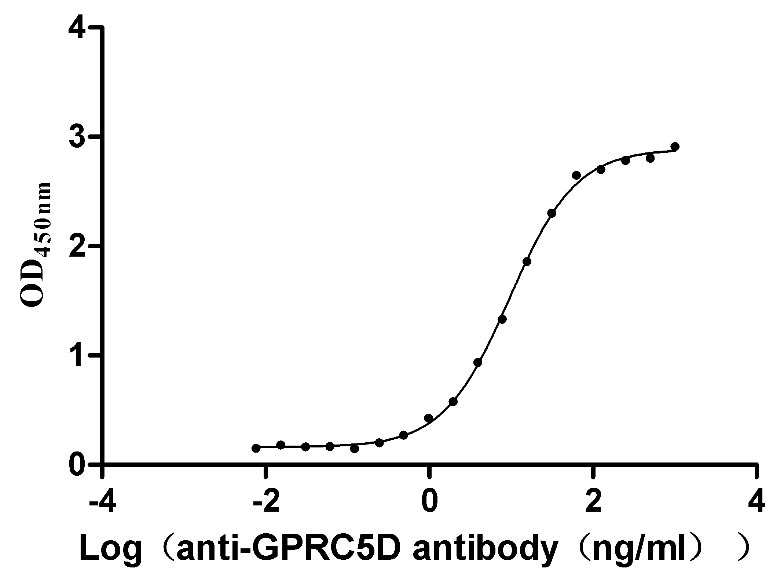Recombinant Mouse Ubiquitin-associated and SH3 domain-containing protein B (Ubash3b)
-
中文名稱:小鼠Ubash3b重組蛋白
-
貨號:CSB-YP804324MO
-
規(guī)格:
-
來源:Yeast
-
其他:
-
中文名稱:小鼠Ubash3b重組蛋白
-
貨號:CSB-EP804324MO
-
規(guī)格:
-
來源:E.coli
-
其他:
-
中文名稱:小鼠Ubash3b重組蛋白
-
貨號:CSB-EP804324MO-B
-
規(guī)格:
-
來源:E.coli
-
共軛:Avi-tag Biotinylated
E. coli biotin ligase (BirA) is highly specific in covalently attaching biotin to the 15 amino acid AviTag peptide. This recombinant protein was biotinylated in vivo by AviTag-BirA technology, which method is BriA catalyzes amide linkage between the biotin and the specific lysine of the AviTag.
-
其他:
-
中文名稱:小鼠Ubash3b重組蛋白
-
貨號:CSB-BP804324MO
-
規(guī)格:
-
來源:Baculovirus
-
其他:
-
中文名稱:小鼠Ubash3b重組蛋白
-
貨號:CSB-MP804324MO
-
規(guī)格:
-
來源:Mammalian cell
-
其他:
產品詳情
-
純度:>85% (SDS-PAGE)
-
基因名:Ubash3b
-
Uniprot No.:
-
別名:Ubash3b; Sts1; Ubiquitin-associated and SH3 domain-containing protein B; EC 3.1.3.48; Cbl-interacting protein p70; Suppressor of T-cell receptor signaling 1; STS-1; T-cell ubiquitin ligand 2; TULA-2; Tyrosine-protein phosphatase STS1/TULA2
-
種屬:Mus musculus (Mouse)
-
蛋白長度:full length protein
-
表達區(qū)域:1-638
-
氨基酸序列MAAREELYSK VTPRRDRLQR PGTVKHGSAL DVLLSMGFPR ARAQKALAST GGRSVQAACD WLFSHVGDPF LDDPLPREYV LYLRPTGPLA QKLSDFWQQS KQICGKNKAH NIFPHITLCQ FFMCEDSKVD ALGEALQTTV SRWKCKFSAP LPLELYTSSN FIGLFVKEDS AEVLKKFAAD FAAEAASKTE VHVEPHKKQL HVTLAYHFQA SHLPTLEKLA QNIDVKLGCD WVATIFSRDI RFANHETLQV IYPYSPQNDD ELELVPGDFI FMSPMEQTST SEGWIYGTSL TTGCSGLLPE NYITKADECS TWIFHGSYSI LNTVSSSSLA FGDGALERRQ YEDQGLGETT PLTIICQPMQ PLRVNSQPGP QKRCLFVCRH GERMDVVFGK YWLSQCFDAK GRYIRTNLNM PHSLPQRSGG FRDYEKDAPI TVFGCMQARL VGEALLESNT VIDHVYCSPS LRCVQTAHNI LKGLQQDNHL KIRVEPGLFE WTKWVAGSTL PAWIPPSELA AANLSVDTTY RPHIPVSKLA ISESYDTYIN RSFQVTKEII SECKSKGNNI LIVAHASSLE ACTCQLQGLS PQNSKDFVQM VRKIPYLGFC SCEELGETGI WQLTDPPILP LTHGPTGGFN WRETLLQE
-
蛋白標簽:Tag?type?will?be?determined?during?the?manufacturing?process.
The tag type will be determined during production process. If you have specified tag type, please tell us and we will develop the specified tag preferentially. -
產品提供形式:Lyophilized powder
Note: We will preferentially ship the format that we have in stock, however, if you have any special requirement for the format, please remark your requirement when placing the order, we will prepare according to your demand. -
復溶:We recommend that this vial be briefly centrifuged prior to opening to bring the contents to the bottom. Please reconstitute protein in deionized sterile water to a concentration of 0.1-1.0 mg/mL.We recommend to add 5-50% of glycerol (final concentration) and aliquot for long-term storage at -20℃/-80℃. Our default final concentration of glycerol is 50%. Customers could use it as reference.
-
儲存條件:Store at -20°C/-80°C upon receipt, aliquoting is necessary for mutiple use. Avoid repeated freeze-thaw cycles.
-
保質期:The shelf life is related to many factors, storage state, buffer ingredients, storage temperature and the stability of the protein itself.
Generally, the shelf life of liquid form is 6 months at -20°C/-80°C. The shelf life of lyophilized form is 12 months at -20°C/-80°C. -
貨期:Delivery time may differ from different purchasing way or location, please kindly consult your local distributors for specific delivery time.Note: All of our proteins are default shipped with normal blue ice packs, if you request to ship with dry ice, please communicate with us in advance and extra fees will be charged.
-
注意事項:Repeated freezing and thawing is not recommended. Store working aliquots at 4°C for up to one week.
-
Datasheet :Please contact us to get it.
靶點詳情
-
功能:Interferes with CBL-mediated down-regulation and degradation of receptor-type tyrosine kinases. Promotes accumulation of activated target receptors, such as T-cell receptors and EGFR, on the cell surface. Exhibits tyrosine phosphatase activity toward several substrates including EGFR, FAK, SYK, and ZAP70. Down-regulates proteins that are dually modified by both protein tyrosine phosphorylation and ubiquitination.
-
基因功能參考文獻:
- Data suggest that Sts1 (suppressor of T-cell receptor signaling-1) negatively regulates TCR (T-cell receptor) signaling in activated T-lymphocytes via dephosphorylation of Zap70. PMID: 24256567
- Sts-1 and Sts-2 are not required for the immune control of murine herpesvirus 68 in a normal course of gammaherpesvirus infection. PMID: 24587276
- The absence of TULA-2 and also the relative level of TULA-2 expression modulates FcgammaRIIA-mediated platelet reactivity and heparin-induced thrombocytopenia in vivo. PMID: 27765766
- dephosphorylation of Tyr(P)(346) may be considered an important "checkpoint" in the regulation of Syk activation process. Putative biological functions of TULA-2-mediated dephosphorylation of Tyr(P)(346) may include deactivation of receptor-activated Syk or suppression of Syk activation by suboptimal stimulation. PMID: 27609517
- Biochemical analysis identified STS-1 and STS-2 as direct phosphatases of FLT3 and c-KIT. PMID: 26365512
- results demonstrate the importance of STS-1 in regulating IFN-alpha-induced autophagy in B cells. PMID: 25959715
- The lack of TULA-2 facilitates T-cell responses to TCR/CD3 stimulation, thus exacerbating T-cell-dependent inflammation. PMID: 25047644
- TULA-2 negatively regulates osteoclast differentiation and function. PMID: 23149425
- Once phosphorylated, tyrosines in carboxyl terminus of protein-tyrosine kinase Syk interact with signaling proteins, including TULA-2, a negative regulator of mast cell degranulation. PMID: 22267732
- Ablation of TULA-2 resulted in hyperphosphorylation of Syk and its downstream effector phospholipase C-gamma2 as well as enhanced GPVI-mediated platelet functional responses. PMID: 20585042
- Syk is a bona fide TULA-2 substrate in platelets. PMID: 20670933
- Taken together, our data clearly demonstrate the ability of reversine to stimulate adipocyte differentiation, which is independent of the Akt and p70(s6k) signaling pathways. PMID: 17490611
顯示更多
收起更多
-
亞細胞定位:Cytoplasm. Nucleus.
-
組織特異性:Detected in splenic T-cells and B-cells, total spleen, skeletal muscle, heart, lung, kidney, thymus, brain and liver (at protein level). Highly expressed in brain. Detected in heart, spleen, lung, liver, kidney and testis.
-
數據庫鏈接:
Most popular with customers
-
Recombinant Human G-protein coupled receptor family C group 5 member D (GPRC5D)-VLPs (Active)
Express system: Mammalian cell
Species: Homo sapiens (Human)
-
Recombinant Human Complement component C1q receptor (CD93), partial (Active)
Express system: Mammalian cell
Species: Homo sapiens (Human)
-
Recombinant Macaca fascicularis Membrane spanning 4-domains A1 (MS4A1)-VLPs (Active)
Express system: Mammalian cell
Species: Macaca fascicularis (Crab-eating macaque) (Cynomolgus monkey)
-
Recombinant Human CUB domain-containing protein 1 (CDCP1), partial (Active)
Express system: Mammalian cell
Species: Homo sapiens (Human)
-
Recombinant Human Killer cell immunoglobulin-like receptor 3DL2 (KIR3DL2), partial (Active)
Express system: Mammalian cell
Species: Homo sapiens (Human)
-
Recombinant Human B- and T-lymphocyte attenuator(BTLA), partial (Active)
Express system: Mammalian cell
Species: Homo sapiens (Human)
-
Recombinant Human Gastric inhibitory polypeptide receptor(GIPR),partial (Active)
Express system: Mammalian cell
Species: Homo sapiens (Human)
-
Recombinant Human Cadherin-1(CDH1),partial (Active)
Express system: Mammalian cell
Species: Homo sapiens (Human)


















